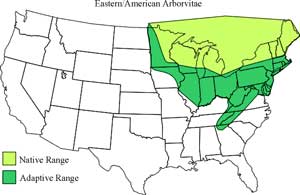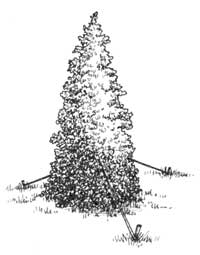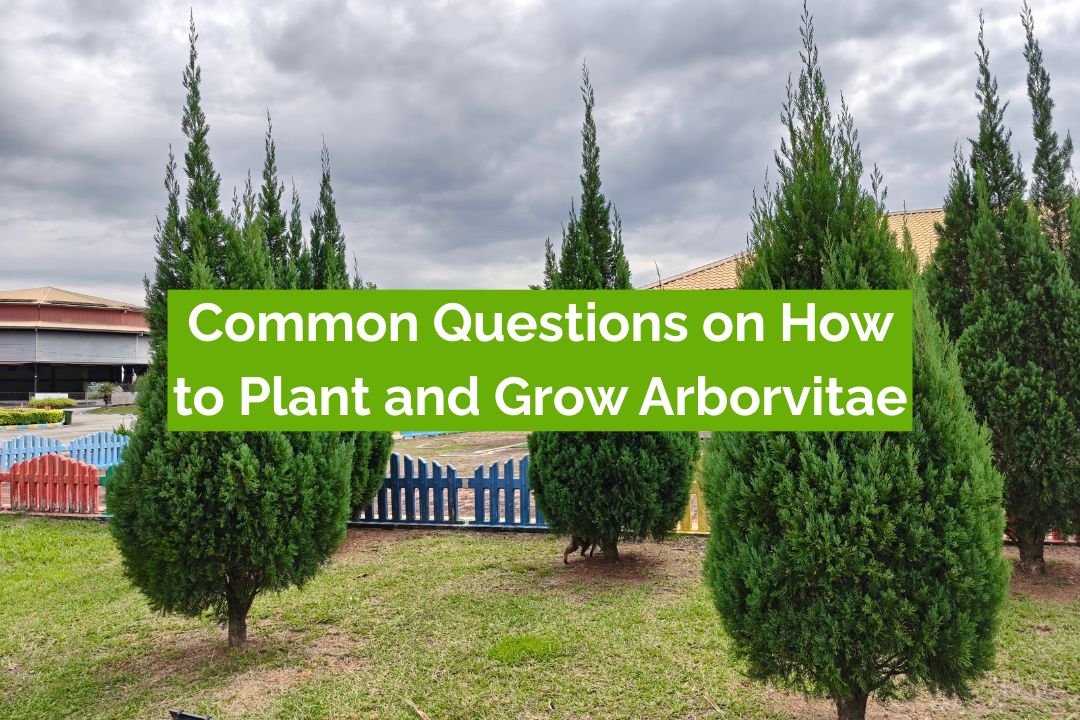 |
American Arborvitae varieties can be grown north well into Canada (zone 2). They survive where winter temperatures are as low as -35°F to -50°F. They are common as far south as southern Pennsylvania and into Virginia and California on the Pacific coast. Oriental arborvitae is more common in the hot southern regions of the US north to Virginia and in protected locations along the mild coastal areas up to Rhode Island.
Arborvitaes generally prefer full sun. While partial shade is desirable in regions where very intense summer sun might scorch them, arborvitaes tend to become ragged if grown in prolonged shade. Varieties having yellow foliage require day-long sun to maintain their stunning color. Though they tolerate either acid or alkaline soil, they prefer deep, moist, well-drained soil rich in organic matter and on the acidic side (pH 5.5 to 6.5).
Arborvitae growing conditions are simple - they do best in moist, well-drained soil and steady sunlight. If one ever needs to be moved, transplanting arborvitae is easiest in early spring or fall when the weather is mild and roots can re-establish quickly.
These trees root easily and grow quickly. Plant 2 to 3 foot tall nursery stock in the spring or fall. Plant arborvitae whose roots are in a ball of soil and wrapped with burlap in spring to early summer. Plant container-grown plants anytime from spring through early fall.
For details on planting trees click here.
 |
| Staking Arborvitae |
Staking
Their dense foliage and relatively small rootballs make newly planted arborvitaes vulnerable to wind in exposed sites. To prevent their being blown over or uprooted before they become established, drive 3 sturdy supporting stakes into the soil equidistant about two feet beyond the arborvitae’s foliage. Loop soft clothesline rope or cables wrapped with rubberized protection where they contact the tender tree bark around the plant stem and then secure the ties to the stakes. Do not put strong tension on them, as the young arborvitae stem needs leeway to move somewhat so it will grow strong. Check often to make sure the cables are not binding or injuring the trunk in any way. Remove staking once the roots are securely anchored in about 6 months.
Conclusion
Planting arborvitae isn’t complicated once you know the basics. With the right timing and care, these evergreens grow quickly and stay full for years. Remember - good soil, steady moisture, and a sunny spot make all the difference when learning how to grow arborvitae. Take your time with planting arborvitae, and you’ll enjoy a healthy, green privacy screen season after season.
Common Questions on How to Plant and Grow Arborvitae

How to plant arborvitae trees?
To plant an arborvitae, dig a hole twice as wide as the root ball but only as deep. Gently loosen the roots and set the tree so the top of the root ball is level with the ground. Backfill with soil, water well to settle, and add a light layer of mulch. Keep the soil moist, that’s the key to planting arborvitae trees that root quickly and stay healthy.
When to plant arborvitae?
The best time to plant arborvitae is in early spring or fall, when the weather is mild, and the soil is easy to work. These seasons give roots time to settle before summer heat or winter frost. Avoid planting in extreme temperatures, gentle conditions help arborvitae establish faster and grow stronger.
How far apart to plant arborvitae?
To understand how close or far apart arborvitae should be planted, think about your goal. For a thick privacy screen, plant them about 5 to 6 feet apart so the branches fill in together. For a more open look, space them 6 to 8 feet apart. Always measure from trunk to trunk and check the mature width of your variety before planting.
How to stake arborvitae trees?
Do you need to stake arborvitae? Only if they’re newly planted or exposed to strong winds. For staking arborvitae, use two or three flexible stakes placed just outside the root ball. Tie the tree loosely with wide fabric or rubber straps so it can sway slightly, this movement helps it grow stronger. Remove the stakes after about six months to a year once the roots are established.
Do arborvitae need full sun?
Arborvitae grow best in full sun, but they can tolerate partial shade. For ideal arborvitae sun requirements, aim for at least six hours of sunlight a day. Too much shade can make them look thin or dull, while a bit of afternoon shade helps in very hot climates.
How deep to plant arborvitae?
Plant arborvitae so the top of the root ball is level with or slightly above the soil surface. The hole should be as deep as the root ball and about twice as wide. Planting too deep can suffocate roots, so keep them near the surface for healthy growth.
How late can you plant arborvitae?
You can plant arborvitae in fall, but do it before the ground freezes so roots can settle in. Early spring is also safe once the soil can be worked. The key is to avoid planting during extreme cold or heat, mild weather helps young trees establish strong roots.
Can you plant arborvitae in a pot?
Yes, arborvitae grow well in large containers if cared for properly. Choose a 20-gallon pot with drainage holes, fill it with good potting mix, and place it where it gets full sun to partial shade. Keep the soil evenly moist and prune occasionally to manage growth.
Can you plant arborvitae in the fall?
Yes, fall is one of the best times to plant arborvitae. Cooler weather reduces stress, and the soil stays warm enough for roots to establish before winter. Just plant early enough before the ground freezes, water regularly, and mulch the base to protect the roots.
Can you plant arborvitae in summer?
You can, but summer planting arborvitae takes extra care. Plant on a cool or cloudy day, water deeply, and keep the soil moist. Mulch around the base to retain water and prevent heat stress. Some types, like Emerald Green, need closer monitoring in hot weather.
Can you plant arborvitae in winter?
You can plant arborvitae in late winter if the ground isn’t frozen. Choose a mild day, water the root ball well, and protect the tree from harsh winds. In colder areas, it’s safer to wait until early spring or fall when planting arborvitae is easier on new roots.
ae

